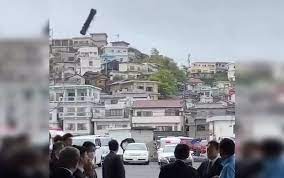Article author: Miky Weinberg – Owner of the Tarantula Technologies Ltd and Octagon Security Ltd Companies.
On Saturday, April 15, 2023, a 24-year-old assassin attempted to assassinate Japanese Prime Minister Fumio Kishida by throwing an explosive device planted inside a pipe. The footage of the moment of the assassination attempt and camera reconstruction provided rare documentation in which the assassin is clearly seen positioning himself in the crowd, reaching a distance of about 10 meters from the prime minister’s location, and throwing the bomb toward him. One of the Prime Minister’s close protection specialists recognized the charge and its fall to the ground, managed to move it away, and carried out an evacuation operation from the hands of the Prime Minister just before the charge exploded.
A news report reviewing the event:
https://www.youtube.com/watch?v=myCqoNo2oug
This is an assassination attempt that takes place about nine months after the assassination of former Japanese Prime Minister Shinzo Abe and it seems that the Japanese close protection unit did not act to change the operational mindset of the Prime Minister’s security and still allows his participation in election events open to the general public without going through a screening process that would make it difficult for a potential assassin to approach the Prime Minister, and thus prevent the introduction of weapons that can be used to harm him.
The current security concept of the Japanese close protection unit puts the array of close protection specialists around the Prime Minister in need of repeatedly dealing with assassins who manage to get close to an effective and dangerous distance without knowing whether they will succeed in the mission of protecting his life. The events of the assassination of Prime Minister Shinzo Abe, in which the security system around him failed to prevent the assassin from firing from a medium range that hit him with fatal shots that killed him, and the current assassination in which one of the close protection specialists managed to prevent Prime Minister Fumio Kishida from being injured, prove that this is a kind of bet on who will win the next assassination attempt, the close protection specialist or the assassin. There is no doubt that the security concept of the Japanese close protection unit places every prime minister under its responsibility in clear and immediate danger.
Here is the footage of the moment when the explosive charge was thrown at the Prime Minister proving the fact that when an unfiltered audience is allowed to reach a short distance from where the principal is, the potential assassin takes advantage of this while realizing that his chances of success in carrying out the assassination are very high:
As a security expert, on the one hand, I admire and praise the quick action of the close protection specialist, which included the identification of the explosive charge, its quick removal, and the determined evacuation of the Prime Minister, which undoubtedly saved him from injury and even possible death, and on the other hand, I do not understand how a close protection unit that has already experienced an assassination of a prime minister continues to work according to a security concept that does not include an audience security screening process. In fact, in the field of close protection, the close protection specialist who is right next to the principal is the last ring that separates the potential assassin from the principal, therefore when the concept of security is based on only one security ring, it is about giving a distinct advantage to the assassin and creating a complex and very difficult professional challenge for the close protection specialists. Following the current assassination attempt on the Japanese Prime Minister, the Japanese government has announced that it will conduct a professional review of the country’s concept of personal security.
The following photo that documents the trajectory of the explosive charge toward the Prime Minister is the best proof in my professional opinion:

There are close protection units such as in Israel and the United States that were able to draw lessons from assassination attempts against prime ministers and presidents that led to an improvement and even a major change in the concept of close protection, and all this to do as much as possible so as not to fail again in dealing with the potential assassin. The security concept of these units includes several rings that combine a response against the existing threats from the adversary. All security rings in this concept are based on professional analysis from the attacker’s viewpoint, which also includes learning from assassination attempt events that occurred in various countries around the world. Those who look at these units from the side can get the impression that this is panic and professional exaggeration and sometimes even as a concept that does not manage risks at all, but for those who are involved in the field of close protection it is clear that the reason for this concept is the acceptance of responsibility for the life of a person chosen for a central public position whose violation can cause loss of life and even influence what is happening in the country.
In conclusion:
The subject of risk management also exists in the field of close protection, but unlike other fields, its significance is a determination of how much one is willing to put one’s personality at risk of harm and how much one is willing to absorb and deal with the consequences when the person is indeed harmed and even dies, therefore it is not possible to determine unequivocally which security concept is better or more suitable for personal protection. In the end, every country conducts itself in risk management including the field of personal security.
Remember, that security should be maintained with full awareness and understanding of risk management!!!